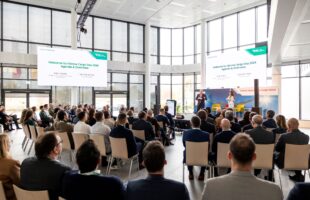The idea is to combine aircraft services with high speed rail in Europe, “to create a new intermodality,†says UPS Transport OHG managing director, Christian Messerschmidt. “We need innovative products to meet the 40-50 per cent growth in European freight movement predicted by 2025,†he said speaking earlier this year in Munich at the Air Cargo Europe event.
The key to the whole concept is a rethinking of traditional rail freight, tapping the technology already widely in use for high speed passenger transport and adapting it to air cargo, premised around the express nature of air cargo.
But proponents of the concept admit that it is not going to be easy to get rolling, despite its cost and inherently environmentally-friendly benefits, pointing to financial and political hurdles, not to mention the serious need to attract cargo volumes, including non-air cargo.
Driven largely by the integrators, two key projects have been underway for a number of years already, including the Euro-Carex (an acronym for Cargo Rail Express) project based out of Paris’ Roissy/Charles de Gaulle (CDG) airport and the ACE (Air Cargo Express) project which initially aims to link up Leipzig/ Halle with Frankfurt.

Euro-Carex
By far the more ambitious of the two projects is the Euro-Carex. Driven by FedEx, Air France Cargo, La Poste, TNT, UPS and French rail operator SNCF, Euro-Carex initially aims to link up a new express freight terminal at Roissy/CDG with high speed trains running to Lyon, Cologne, Liege, Amsterdam, Lille and London in the first phase from 2012 and in its second phase from 2015 extend the network to Frankfurt, Bordeaux and Marseille. A third phase by 2020 could see links to hubs in Italy and Spain.
At both CDG and Cologne, FedEx has undertaken major investment to expand the Paris hub as well as building a major new facility in Cologne to accommodate the influx of traffic following the announcement by the US-based express carrier that it was shifting its main hub for central and Eastern Europe from Frankfurt. The CDG expansion is slated for completion by end-2009, while the new Cologne hub will be completed by end-first quarter 2010.
Euro-Carex president Yanick Paternotte has previously said that the organisation will initially employ eight high speed trains specially designed for air cargo with a capacity to transport up to 100 tonnes of express shipments per train each night. He puts the investment at about €600 million for trains and €300 million for terminals.
The Euro-Carex proposition also has the advantage of resting on firmer rails. The French high speed rail network is not only more extensive, but generally acknowledged to be of better quality than its German equivalent.
The Euro-Carex venture also has a working precursor in the form of French postal service La Poste’s TGV Fret freight express trains, between Paris and Lyon. The trains are manufactured by French rail producer Alstom which will also supply trains for the Carex venture.
The new trains are to be based on the double-decker TGV Duplex trains used by TGV Fret and will accommodate standard airfreight containers up to three metres tall.
Cologne was destined to be the first airport linked to Paris by 2012, according to Eckhard Kuhla, director of Ekonsult Gmbh, which provides consultancy services for the European Intermodal Association, but he said no decision has been made whether to build an express rail freight terminal at the Cologne/Bonn airport, despite the strong integrator presence by both FedEx and UPS which established its European hub there in 1986.
“We have the lines,†Kuhla said in reference to Cologne’s high speed rail connections to Paris via Frankfurt. “But what we need now is a new rail freight stationâ€Â. This he said, will require political support in order to gather the necessary investment.
Air Cargo Express (ACE)
The ACE project on the other hand, while somewhat more limited in itsintended scope, is actually closer to realization having already built anexpress freight terminal at Leipzig/Halle airport and undertaken initialtesting. The project is being drivenprimarily by DHL, with the first phaseseeing cargo shuttled via express trainsbetween Leipzig/Halle and Frankfurtairports. At a later stage other Germanairports including Hamburg, Munich andDüsseldorf will be linked.
Speaking enthusiastically of his airport’s unique potential as a “tri-modal†hub, Dierck Näther, managing director of Leipzig/Halle airport told the Munich conference that part of the strategic position of the eastern German airport was premised around creating an allcargo- hub as compared to Frankfurt’s position as primarily a belly cargo hub. And part of this strategic plan was to build a cargo railway station at Leipzig/ Halle and “now it’s a reality,†he says, “you can see it, you can touch itâ€Â.
This puts the airport and the ACE project in a rather unique position of being the first airport to have experience in developing and operating a modern express rail freight terminal.
Näther noted that much planning and analysis went into the project, in particular not just the aspect of fast trains, but fast handling to enable one train to be unloaded within 15-20 minutes.
This is made possible by simultaneously loading and unloading of the seven ULDs in each freight car. To accomplish this, moveable rail docks are positioned on each side of the freight wagons which raise and lower from the cars to roller racks capable of storing eight ULDs each. The rail station consists of two parallel head tracks 35 metres apart which enables it to handle two trains at the same time.
Phase one testing has gone well according to Näther, with trains up to 400 metres in length running at 160 km/hr taking about four hours between Leipzig/Halle and Frankfurt.
Ultimately the plan is to use special train wagons capable of doing 200 km/hr, but Näther notes that the prerequisite is the availability of high speed rail tracks. For both of these conditions to be met, he’s aiming for 2015.
In the meantime the original plan slated operations to start by 2009 but he said that while DHL was clearly committed and the driver of the project from the very beginning, “it was obvious we needed other partners to start the train and so we are now working together to find other co-loading customers, including non-air cargo freight.â€Â
Payload Asia now understands that lack of interest in the service has prompted Leipzig/Halle to undertake a new marketing initiative from early 2010 to market the express cargo service effectively as an airport cargo train, rather than a DHL Express/Lufthansa Cargo project. The hope is that this will help attract key players like Schenker and other freight forwarders who have shown little interest to date.
The challenges
Indeed the obstacles for both projects appear to be momentous. As UPS’ Messerschmidt highlights, over the years that the express rail cargo concept has been developing so too have customer expectations for any high-speed rail service for express goods.
Services must offer speeds of at least 200km/h to beat road transit times but must offer costs less than that of air cargo. The services must be reliable and suitable for time-sensitive products, as well as deferred deliveries and they must meet the requirements of security and even temperature sensitive cargo.
Also speaking at the conference, Amsterdam Airport Schiphol senior vice president cargo, Enno Osinga said he finds the topic, “the most deeply frustrating topic we can possibly talk about.†Why? Because it depends on two things: Infrastructure and politics. “And these are things that do not run very fast,†Osinga said wryly.
“It is an exciting world, but it is still an exciting world of artist’s impressions. So there’s a lot of thinking, but we still have to get there.â€Â
As a new transport mode for air cargo, rail transport is something “we have to learn to live with,†adding it has a lot to do with technical issues – “but the solutions are thereâ€Â. But for Osinga and Schiphol, the issue is far more than just fast trains or terminals. “The key thing we are addressing is airport accessibility,â€Âhe says.
“Night bans are perceived as a threat at virtually all airports. But at Schiphol we view night bans as an opportunity. We invest heavily in high speed rail, why?
“Because if we have high speed rail connection between Schiphol and Paris we can stop the FedEx flights that connect Amsterdam to the hub in Paris. If ultimately we have a connection to Leipzig we can stop the DHL flights,†Osinga says.
“It’s very funny when an airport is investing in stopping flights, but the key thing is, because we are so actively involved in stopping flights, and we are so actively involved in reducing any noise disturbance that there may be, we’re allowed to keep our nights open. So we keep our nights open for the traffic that really needs it – and we’re excited by that,†he adds.
But more to the point he says it’s not only important to make efficient use of the existing infrastructure, but it’s crucial to have the volumes. “It’s very exciting to build a whole structure around air cargo, but you’re never going to fill it with just air cargo. We need to focus on developing new markets – it’s not just about building a station, it’s about building a logistics city that’s going to support the whole project.â€Â
“Something we’re all struggling with is how do you get it off the ground. We’re all very excited about it, but not one single party can get it off the ground,†he says pointing to the need for all stakeholders to be involved, “the entire community,†including different levels of government. At Schiphol this is encapsulated in the initiative group – Amsterdam Connecting Trade (ACT).
While the benefits are clear to Osinga, whether it be fresh flowers from the Netherlands flower auction to France, Italy or Spain, or other cargo sitting alongside the integrators, he’s not so optimistic on 2012. “I don’t think it will be ready until 2013, but it will be there, and it must be there as part of a conglomerate of activities, that is the key thing.â€Â
The frustrations
The key element is the political angle. Talking European rail is never going to work unless it is approached on a European scale, Osinga urges.
There are initiatives taking place in Germany, France, the Netherlands and other places, “but unless we somehow get it on the European political agenda, somehow get European railways to stop being national railways and become European railways; as long as infrastructure companies stop thinking they are local/ national infrastructure companies and become European ones, technical issues will not be our challenge, it’s going to be politics that is going to be our challenge to make this work.â€Â
But he never-the-less holds out hope, expressing excitement that a strong business case is there, the partners are there, the commitment is there, “all we need to do now is a little bit of convincing – but with a good business case we’ll get there.â€Â









